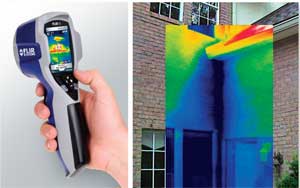Two Paths
As before, there are two ways for a home to become Energy Star certified: The performance path and prescriptive path.
Most choose to go through the performance path, in which the builder must get home plans approved prior to construction and, if approved, adhere to the projected goals. The prescriptive path requires no plan approval, but strictly regulates which products and appliances are in the home to ensure energy savings comparable to the performance path.
Once the builder chooses a path, he must go through a few steps in order for a home to become Energy Star certified. First, he must partner with the Energy Star program by filling out a free online submission form that is then evaluated by Energy Star staff.
Then the builder must find a Home Energy Rater System (HERS) rater to work with him. HERS is an independent third party monitored by Residential Energy Services Network, a government-recognized company created to monitor home energy efficiency for incentive programs. HERS raters are trained to evaluate construction techniques, take measurements and perform inspections that ensure the builder is meeting Energy Star standards.
Once the builder is certified and links up with HERS, they work together to ensure the home is up to Energy Star standards. If the home has passed all tests and HERS reports the home and builder have met all guidelines, the home is considered Energy Star certified.
Although there are a few other programs offering similar efficiency requirements, Energy Star seems to be most popular in the United States. Rashkin says this is due to a variety of reasons. When Energy Star for homes was introduced, the construction industry was ready for this type of program.
Also, the specifications have progressed gradually. They did not require standards that would be too difficult for homeowners or builders at the time. As Americans’ views about efficient homes have progressed, the standards for these homes have increased.
“We keep improving how we do our program without increasing resources,” Rashkin said. “It comes down to right culture, right product, right strategy, right people, right message.”
–Jessica Porter is a writer who lives in northern Virginia.
Tracking Energy Star’s Ascent
Since its inception, the Energy Star program has sought to be the rabbit that only a minority of homebuilders can catch. Today, the Energy Star label goes on only those houses that are 20% to 30% more efficient than standard homes. As building practices have improved over the years, Energy Star for Homes’ leaders have made it more rigorous. Here’s how Energy Star’s requirements have been expanded and toughened over the years. Each new version’s requirements incorporate all the areas listed in the previous version, and in some cases the standard to be met (such as for minimum insulation values) has been raised. Energy Star program director Sam Rashkin says the program’s evolution in part reflects new knowledge about optimal home performance.
The Final Frontier
What’s next for Energy Star isn’t a plan so much as a concept.
After the third version of Energy Star for Homes blasts off next year, the program will near its final stage with the launch of the concept home, an ideal version of home energy efficiency.
The concept home is the compilation of the three versions of Energy Star for Homes, the last of which will be released next year and which set standards for efficient homebuilding. The goal is to create a perfectly net-zero home that will, when paired with participating homeowners, produce little to no carbon emissions.
From building practices (in which the home will be built in less time using only as much material as necessary and wasting little) to appliances, the concept home will provide a model that all homebuilders should aspire to recreate.
In order to make net-zero possible, the concept home will include features such as designing square footage that is 100% functional; installing proper ducts, plumbing, wiring and HVAC equipment; and ensuring the correct amount of heating and cooling is used.
“Everything’s fully addressed (in the concept home) so you know everything you should do. It will take the home to that next level,” says Sam Rashkin, national director of Energy Star for Homes.
When the program began with Version 1 in 1996, Energy Star knew the concept home would be the final result. However, at that time energy efficiency was not as valued as it is today, so smaller steps had to be taken to gradually make improvements.
“We knew this is where things had to be. But that desired level was too difficult for the industry at the time,” says Rashkin.
Energy Star expects the new version to redefine a normal house. And now that people realize the importance of quality appliances and home-building practices, making these features affordable is key. As technology evolves and homes like this become more affordable, Rashkin believes the concept home will become commonplace.



